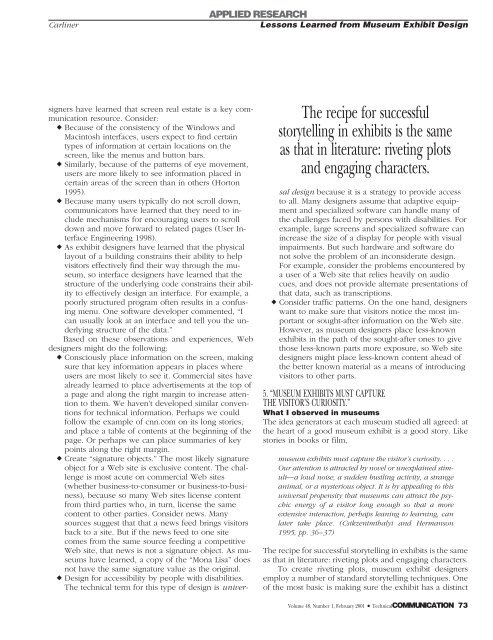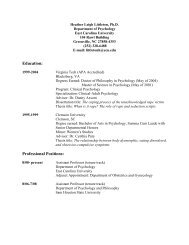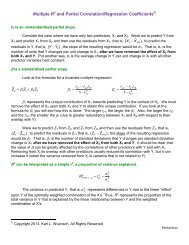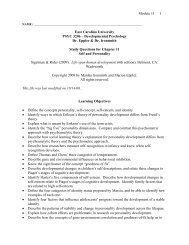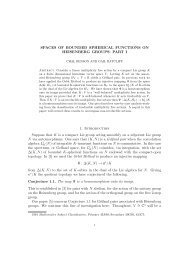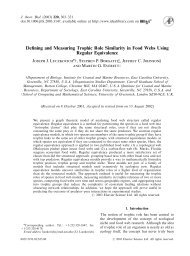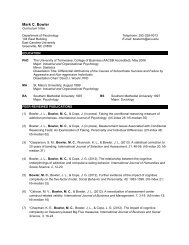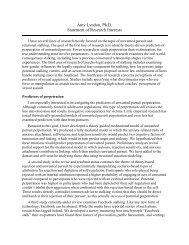Modeling Information for Three-Dimensional Space - Ecu
Modeling Information for Three-Dimensional Space - Ecu
Modeling Information for Three-Dimensional Space - Ecu
Create successful ePaper yourself
Turn your PDF publications into a flip-book with our unique Google optimized e-Paper software.
Carliner<br />
APPLIED RESEARCH<br />
Lessons Learned from Museum Exhibit Design<br />
The recipe <strong>for</strong> successful<br />
storytelling in exhibits is the same<br />
as that in literature: riveting plots<br />
and engaging characters.<br />
signers have learned that screen real estate is a key communication<br />
resource. Consider:<br />
Because of the consistency of the Windows and<br />
Macintosh interfaces, users expect to find certain<br />
types of in<strong>for</strong>mation at certain locations on the<br />
screen, like the menus and button bars.<br />
Similarly, because of the patterns of eye movement,<br />
users are more likely to see in<strong>for</strong>mation placed in<br />
certain areas of the screen than in others (Horton<br />
1995).<br />
Because many users typically do not scroll down,<br />
communicators have learned that they need to include<br />
mechanisms <strong>for</strong> encouraging users to scroll<br />
down and move <strong>for</strong>ward to related pages (User Interface<br />
Engineering 1998).<br />
As exhibit designers have learned that the physical<br />
layout of a building constrains their ability to help<br />
visitors effectively find their way through the museum,<br />
so interface designers have learned that the<br />
structure of the underlying code constrains their ability<br />
to effectively design an interface. For example, a<br />
poorly structured program often results in a confusing<br />
menu. One software developer commented, “I<br />
can usually look at an interface and tell you the underlying<br />
structure of the data.”<br />
Based on these observations and experiences, Web<br />
designers might do the following:<br />
Consciously place in<strong>for</strong>mation on the screen, making<br />
sure that key in<strong>for</strong>mation appears in places where<br />
users are most likely to see it. Commercial sites have<br />
already learned to place advertisements at the top of<br />
a page and along the right margin to increase attention<br />
to them. We haven’t developed similar conventions<br />
<strong>for</strong> technical in<strong>for</strong>mation. Perhaps we could<br />
follow the example of cnn.com on its long stories,<br />
and place a table of contents at the beginning of the<br />
page. Or perhaps we can place summaries of key<br />
points along the right margin.<br />
Create “signature objects.” The most likely signature<br />
object <strong>for</strong> a Web site is exclusive content. The challenge<br />
is most acute on commercial Web sites<br />
(whether business-to-consumer or business-to-business),<br />
because so many Web sites license content<br />
from third parties who, in turn, license the same<br />
content to other parties. Consider news. Many<br />
sources suggest that that a news feed brings visitors<br />
back to a site. But if the news feed to one site<br />
comes from the same source feeding a competitive<br />
Web site, that news is not a signature object. As museums<br />
have learned, a copy of the “Mona Lisa” does<br />
not have the same signature value as the original.<br />
Design <strong>for</strong> accessibility by people with disabilities.<br />
The technical term <strong>for</strong> this type of design is universal<br />
design because it is a strategy to provide access<br />
to all. Many designers assume that adaptive equipment<br />
and specialized software can handle many of<br />
the challenges faced by persons with disabilities. For<br />
example, large screens and specialized software can<br />
increase the size of a display <strong>for</strong> people with visual<br />
impairments. But such hardware and software do<br />
not solve the problem of an inconsiderate design.<br />
For example, consider the problems encountered by<br />
a user of a Web site that relies heavily on audio<br />
cues, and does not provide alternate presentations of<br />
that data, such as transcriptions.<br />
Consider traffic patterns. On the one hand, designers<br />
want to make sure that visitors notice the most important<br />
or sought-after in<strong>for</strong>mation on the Web site.<br />
However, as museum designers place less-known<br />
exhibits in the path of the sought-after ones to give<br />
those less-known parts more exposure, so Web site<br />
designers might place less-known content ahead of<br />
the better known material as a means of introducing<br />
visitors to other parts.<br />
5. “MUSEUM EXHIBITS MUST CAPTURE<br />
THE VISITOR’S CURIOSITY.”<br />
What I observed in museums<br />
The idea generators at each museum studied all agreed: at<br />
the heart of a good museum exhibit is a good story. Like<br />
stories in books or film,<br />
museum exhibits must capture the visitor’s curiosity. ...<br />
Our attention is attracted by novel or unexplained stimuli—a<br />
loud noise, a sudden bustling activity, a strange<br />
animal, or a mysterious object. It is by appealing to this<br />
universal propensity that museums can attract the psychic<br />
energy of a visitor long enough so that a more<br />
extensive interaction, perhaps leaning to learning, can<br />
later take place. (Csikzentmihalyi and Hermanson<br />
1995, pp. 36–37)<br />
The recipe <strong>for</strong> successful storytelling in exhibits is the same<br />
as that in literature: riveting plots and engaging characters.<br />
To create riveting plots, museum exhibit designers<br />
employ a number of standard storytelling techniques. One<br />
of the most basic is making sure the exhibit has a distinct<br />
Volume 48, Number 1, February 2001 • TechnicalCOMMUNICATION 73


